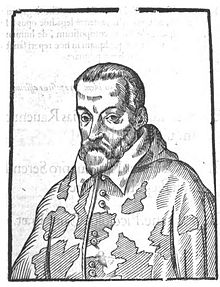Luigi d'Este (21 December 1538 – 30 December 1586) was an Italian Catholic cardinal, the second son of the five children of Ercole II d'Este, Duke of Modena and Ferrara, and Renée de Valois, daughter of Louis XII of France.

Biography
Luigi, a member of the House of Este, was born in Ferrara. A man of the world whose personal emblem was Prometheus bearing fire in the stalk of fennel, he was made a Cardinal of the Roman Catholic Church in Pius IV's consistory of 26 February 1561 and served as Cardinal Protector of the kingdom of France, which made him one of the most powerful and influential members of the College of Cardinals; he kept as his secretary Arnaud d'Ossat, a skillful French diplomat who was eventually made a cardinal himself.
He was Bishop of Ferrara (1550) and Apostolic Administrator of Ferrara (1561 – 8 October 1563), deacon of S. Angelo in Pescheria (1577–1583) He participated in the Papal conclave, 1565–1566 but not in the conclave of 1572, as he was absent in France. He played a key role, however, in the Papal conclave, 1585.
Luigi d'Este lived partly in Rome and partly at the Villa d'Este, Tivoli, built for his uncle Ippolito II d'Este. In Rome he rented from the Orsini an agglomeration of case at Montegiordano, near Piazza Navona, where he kept in attendance the large famiglia or household expected of a man of his birth and position, and a villa suburbana on the Quirinal that is now the residence of the President of Italy. Careless of his mounting debts, Cardinal d'Este was the most influential patron of the madrigal composer Luca Marenzio, whom he employed as maestro di cappella from August 1578 until the time of his death: during the eight-year period, Marco Bizzarini observes, Marenzio published some two-thirds of his copious output. To Cardinal d'Este Marenzio dedicated his Primo libro de' madrigali a5, 1580, "because of the debt of an infinite number of favours", and books of motets published at Venice were dedicated by Bertoldo Sperindio (1562) and Francesco Portinaro (1568). Cardinal d'Este was a generous patron of scholars, men of letters—like the poet Torquato Tasso, who was taken to Paris in 1565 in the Cardinal's household and dedicated his Rinaldo to him but was deemed mentally unstable in 1579 and confined at Ferrara for several years, during which he wrote a number of philosophical dialogues and discourses—and scientists, such as the Neapolitan polymath Giambattista della Porta, whom he invited to join him in Rome in 1579. Among the Cardinal's paintings was Correggio's Mystic Marriage of Saint Catherine, now in the Louvre.
He died in Rome in 1586. He bequeathed his entire estate to his brother Alfonso II d'Este. Luigi d'Este is buried in the church of S. Maria Maggiore (commonly known as S. Francesco), Tivoli.
Ancestry
| Ancestors of Luigi d'Este | ||||||||||||||||||||||||||||||||||||||||||||||||||||||||||||||||||||||||||||||||||||||||||||||||||||||||||||||||||||||||||||||||||||||||||||||||||||||||||||||||||||||||||||||||||||||||||||||||||||||||||||||||||||||||||||||||||||||||||||||||||||||||||||||||||||||||||||||||||||||||||||||||||||||||||||||||||||||||||||||||||||||||||||||||||||||||||||||||||||||||||||||||||||||||||||||||||||||||||||||||||||||||||||||||||||||||||||||||||||||||||||||||||||||||||||||||||||||||||||||||||||||||||||||||||||||||||||||||||||||||||||||||||||||||||||||||||||||||||||||||||||||||||||||||||||||||||||||||
|---|---|---|---|---|---|---|---|---|---|---|---|---|---|---|---|---|---|---|---|---|---|---|---|---|---|---|---|---|---|---|---|---|---|---|---|---|---|---|---|---|---|---|---|---|---|---|---|---|---|---|---|---|---|---|---|---|---|---|---|---|---|---|---|---|---|---|---|---|---|---|---|---|---|---|---|---|---|---|---|---|---|---|---|---|---|---|---|---|---|---|---|---|---|---|---|---|---|---|---|---|---|---|---|---|---|---|---|---|---|---|---|---|---|---|---|---|---|---|---|---|---|---|---|---|---|---|---|---|---|---|---|---|---|---|---|---|---|---|---|---|---|---|---|---|---|---|---|---|---|---|---|---|---|---|---|---|---|---|---|---|---|---|---|---|---|---|---|---|---|---|---|---|---|---|---|---|---|---|---|---|---|---|---|---|---|---|---|---|---|---|---|---|---|---|---|---|---|---|---|---|---|---|---|---|---|---|---|---|---|---|---|---|---|---|---|---|---|---|---|---|---|---|---|---|---|---|---|---|---|---|---|---|---|---|---|---|---|---|---|---|---|---|---|---|---|---|---|---|---|---|---|---|---|---|---|---|---|---|---|---|---|---|---|---|---|---|---|---|---|---|---|---|---|---|---|---|---|---|---|---|---|---|---|---|---|---|---|---|---|---|---|---|---|---|---|---|---|---|---|---|---|---|---|---|---|---|---|---|---|---|---|---|---|---|---|---|---|---|---|---|---|---|---|---|---|---|---|---|---|---|---|---|---|---|---|---|---|---|---|---|---|---|---|---|---|---|---|---|---|---|---|---|---|---|---|---|---|---|---|---|---|---|---|---|---|---|---|---|---|---|---|---|---|---|---|---|---|---|---|---|---|---|---|---|---|---|---|---|---|---|---|---|---|---|---|---|---|---|---|---|---|---|---|---|---|---|---|---|---|---|---|---|---|---|---|---|---|---|---|---|---|---|---|---|---|---|---|---|---|---|---|---|---|---|---|---|---|---|---|---|---|---|---|---|---|---|---|---|---|---|---|---|---|---|---|---|---|---|---|---|---|---|---|---|---|---|---|---|---|---|---|---|---|---|---|---|---|---|---|---|---|---|---|---|---|---|---|---|---|---|---|---|---|---|---|---|---|---|---|---|---|---|---|---|---|---|---|---|---|---|---|---|---|---|---|---|---|---|---|---|---|---|---|---|---|---|---|---|---|---|---|---|---|---|---|---|---|---|---|---|---|---|---|---|---|---|---|---|---|---|---|---|---|---|---|---|---|---|---|---|---|---|---|---|---|---|---|---|---|---|---|---|---|---|---|---|---|---|---|---|---|---|---|---|---|---|---|---|---|---|---|---|
| ||||||||||||||||||||||||||||||||||||||||||||||||||||||||||||||||||||||||||||||||||||||||||||||||||||||||||||||||||||||||||||||||||||||||||||||||||||||||||||||||||||||||||||||||||||||||||||||||||||||||||||||||||||||||||||||||||||||||||||||||||||||||||||||||||||||||||||||||||||||||||||||||||||||||||||||||||||||||||||||||||||||||||||||||||||||||||||||||||||||||||||||||||||||||||||||||||||||||||||||||||||||||||||||||||||||||||||||||||||||||||||||||||||||||||||||||||||||||||||||||||||||||||||||||||||||||||||||||||||||||||||||||||||||||||||||||||||||||||||||||||||||||||||||||||||||||||||||||
References
- Vincenzo Pacifici, Luigi d'Este, in Atti e Memorie della Società Tiburtina di Storia e d'Arte, vol. IX-X (1929-30), pp. 3-128
- Este genealogical chart.
- His liaison with the noble and musical Lucrezia Bendidio, whose favours were shared with Torquato Tasso, was well known. (Franca Trinchieri Camiz and Katherine A. McIver, Art and Music in the Early Modern Period 2003:148).
- R. A. Scorza, "Vincenzo Borghini and the Impresa" Journal of the Warburg and Courtauld Institutes 52 (1989:85–110) p. 97.
- Miranda, Salvador. "ESTE, Luigi d' (1538-1586)". The Cardinals of the Holy Roman Church. Florida International University. OCLC 53276621.
- Archdiocese of Ferrara.
- Miranda, Salvador. "Deaconries". The Cardinals of the Holy Roman Church. Florida International University. OCLC 53276621.
- The young architect Flaminio Ponzio made his first documented appearance there in 1585, providing some minor new outbuildings in the outer park (David R, Coffin, The villa d'Este at Tivoli).
- ^ See G. Fragnito, "'Parenti' et 'familiari' nelli corti cardinalizie del rinascimento", in C. Mozzarelli, ed. Familgia' del principe e famiglia aristocratica (Rome) 1988; a list of 1579 notes 34 prelates and noblemen, with their 73 servants, 66 lesser individuals sharing 44 further servants, plus pages, footmen, kitchen and stable staff, falconers and bakers that served the household in general (Marco Bizzarini, "Marenzio and Cardinal Luigi d'Este" Early Music 27.4, (November 1999:519–532) p. 520.
- His benefices, when they were taxed in 1571, amounted to 19,665 scudi a year, more than Alessandro Farnese's (16,750 scudi) or Giulio Della Rovere's (16,267 scudi), according to figures noted in Gianvittorio Signorotto and Maria Antonietta Visceglia, Court and Politics in Papal Rome, 1492–1700 2002:61).
- Bizzarini 1999:519
- Jane A. Bernstein, Music Printing in Renaissance Venice: The Scotto Press (1539–1572) (1998:203).
- Paolo Portone, in Dizionario biografico degli italiani, vol. 43 (Rome 1993) s.v. "Este, Luigi d'".
- Deuotissime orationi ch’ogni notte, Oltre il diuino Offitio, soleua dire la fe. me. Dell'illustriss. et reuerrndiss Sig. Cardinal d'Este, 1588, facsimile edition with biography, Second edition increased, 2013
| Princes of Modena | |
|---|---|
| Generations start from Ercole I d'Este, first Duke of Modena | |
| 1st generation | |
| 2nd generation | |
| 3rd generation | |
| 4th generation | |
| 5th generation | |
| 6th generation | |
| 7th generation | |
| 8th generation | |
| 10th generation | |
| 11th generation | |
| *also Archduke of Austria | |